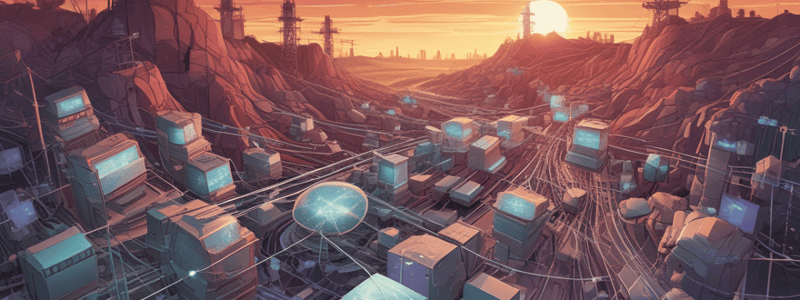Podcast
Questions and Answers
What is the main function of a layer one hub?
What is the main function of a layer one hub?
- Forwarding packets based on IP addresses
- Routing traffic to different networks
- Switching frames between devices
- Repeating signals on all ports (correct)
What type of addressing does a layer one hub have no concept of?
What type of addressing does a layer one hub have no concept of?
- Layer 3 IP addresses
- Application layer ports
- Layer 2 addresses
- Any type of addressing or framing (correct)
What is the primary difference between a hub and a switch?
What is the primary difference between a hub and a switch?
- A switch is more expensive than a hub
- A switch is a layer 2 device, while a hub is layer 1 (correct)
- A hub has more ports than a switch
- A hub is faster than a switch
What happens when a signal is sent to a hub?
What happens when a signal is sent to a hub?
What is an example of a layer one forwarding device?
What is an example of a layer one forwarding device?
What type of topology is described in the video?
What type of topology is described in the video?
At which layer of the TCP/IP protocol suite does a hub operate?
At which layer of the TCP/IP protocol suite does a hub operate?
What is the advantage of using a hub over a router?
What is the advantage of using a hub over a router?
What is the logical topology of a hub at layer one?
What is the logical topology of a hub at layer one?
What happens when two devices try to send signals at the same time in a hub?
What happens when two devices try to send signals at the same time in a hub?
What is a collision domain?
What is a collision domain?
Why do devices in a hub environment use CSMA/CD?
Why do devices in a hub environment use CSMA/CD?
What does the 'multiple access' part of CSMA/CD mean?
What does the 'multiple access' part of CSMA/CD mean?
What is the mode of operation in a hub environment?
What is the mode of operation in a hub environment?
What is the physical topology of a hub?
What is the physical topology of a hub?
What happens when two devices try to send signals at the same time in a hub, and a collision occurs?
What happens when two devices try to send signals at the same time in a hub, and a collision occurs?
What is the purpose of the carrier sensing part of CSMA/CD?
What is the purpose of the carrier sensing part of CSMA/CD?
What is the difference between a hub and a layer 2 switch?
What is the difference between a hub and a layer 2 switch?
What is the primary function of a hub in a network?
What is the primary function of a hub in a network?
What is the main difference between a hub and a repeater?
What is the main difference between a hub and a repeater?
What is an example of a layer 1 device that can convert electrical signals to light signals?
What is an example of a layer 1 device that can convert electrical signals to light signals?
What is the concept in IPv4 networks where a device sends a request to all devices on the network?
What is the concept in IPv4 networks where a device sends a request to all devices on the network?
What is the term for the limits of how many devices will receive a broadcast message?
What is the term for the limits of how many devices will receive a broadcast message?
Why is an ARP request sent as a broadcast?
Why is an ARP request sent as a broadcast?
What is the main reason why hubs are not commonly used in modern networks?
What is the main reason why hubs are not commonly used in modern networks?
What is the term for a device that forwards signals it receives on one port to all other ports?
What is the term for a device that forwards signals it receives on one port to all other ports?
What is the primary difference between a hub and a layer 2 switch?
What is the primary difference between a hub and a layer 2 switch?
What is an ARP request used for in a network?
What is an ARP request used for in a network?
Flashcards are hidden until you start studying
Study Notes
Layer 1 - Physical Layer
-
The physical layer is the bottom layer of the TCP/IP protocol suite, and it deals with sending information on the network
-
At layer 1, we need a device that is not quite as smart as a switch, and options include a hub or a repeater
A hub and a repeater serve different purposes in a network:
1. Hub:
-
Function: A hub is a multi-port device that connects multiple computers or network devices in a local area network (LAN).
-
Operation: It operates at the physical layer (Layer 1) of the OSI model and broadcasts incoming data packets to all ports, regardless of the destination.
-
Intelligence: Hubs are not intelligent devices; they do not filter or route the data.
-
Collision Domain: All devices connected to a hub share the same collision domain, which can lead to data collisions and network inefficiency.
2. Repeater:
-
Function: A repeater is a device that regenerates and amplifies signals to extend the distance over which data can travel in a network.
-
Operation: It also operates at the physical layer (Layer 1) of the OSI model but has only two ports (one incoming and one outgoing). It strengthens the signal without altering the data content.
-
Intelligence: Repeaters are simpler than hubs; their sole purpose is to enable longer transmissions by counteracting signal degradation over distance.
-
Collision Domain: Repeaters do not impact the collision domain; they simply regenerate the signal within the existing network segment.
In summary, while both devices operate at the physical layer, a hub connects multiple devices within a network and broadcasts data to all ports, affecting network performance. A repeater, on the other hand, is used to extend the range of the network by regenerating signals without contributing to network congestion.
-
Hubs
- A layer 1 hub is a multi-port repeater that takes signals that come in on one port and forwards them out all other ports
- Hubs have no concept of addressing, framing, or packets; they only forward signals
- In a hub environment, all devices connected to the hub share the same bandwidth and are on the same network
- A hub acts as a logical bus, but physically it's a star topology with the hub in the center
- With a hub, only one device can talk at a time, and if two devices try to send signals at the same time, there's a collision
- A hub is a single collision domain, and devices connected to it use half-duplex communication (send or receive, but not both at the same time)
- Devices connected to a hub use CSMA/CD (carrier sensing multiple access with collision detection) to avoid collisions
CSMA/CD
- Carrier sensing: devices check to see if the network is clear before sending data
- Multiple access: multiple devices can be connected to the hub and share the collision domain
- Collision detection: devices can detect when a collision occurs and respond accordingly
Broadcast Domain
- A broadcast is like an all-points bulletin that is sent to every device on the network
- In a layer 1 environment, a broadcast is sent to every device on the network segment
- A broadcast domain represents the limits of how many devices will hear the broadcast
Other Layer 1 Devices
- Repeaters: take signals that come in on one side and send them out the other
- Media converters: convert electrical signals to light signals or vice versa
Limitations of Hubs
- Hubs are not very smart and only forward every bit they hear
- They don't care about layer 2 or layer 3 addressing or anything higher in the protocol stack
- In modern networks, hubs are not commonly used and are being replaced by layer 2 switches
Studying That Suits You
Use AI to generate personalized quizzes and flashcards to suit your learning preferences.





